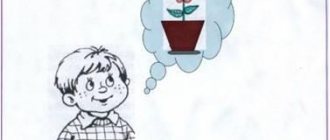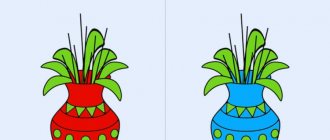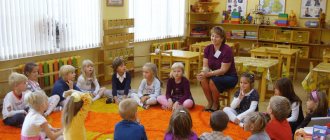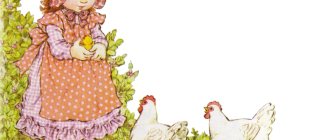Cheat sheets for exams and tests
| See also... |
| Methods of environmental education |
| Objectives and content of environmental education in the pedagogical process of a preschool educational institution. |
| The concept of environmental education for preschool children. |
| Modern environmental programs of preschool institutions. |
| Partial programs |
| Methods of environmental education for preschool children. A variety of methods of environmental education for preschool children. Observation is a method of sensory knowledge of nature. |
| The value of illustrative aids. |
| The structure of children's experimentation. |
| Methodology for conducting the experiment. |
| Contents of work on caring for animals and plants and methods of managing them |
| Requirements for organizing work in a corner of nature |
| Game as a method of introducing children to nature |
| Modeling |
| Teacher's story. |
| Forms of environmental education for preschool children. Classes on environmental education for preschool children. |
| Preparation and conduct of classes. |
| Excursions and walks in nature and their significance. Environmental actions. |
| Methodology for conducting natural history excursions. |
| Elementary search activity. |
| Ecological holidays and entertainment |
| .Organization of an ecological and developmental environment in preschool institutions. Developing ecological environment in preschool educational institutions. Definition of a developing ecological environment |
| Nature room |
| Laboratory |
| Wildlife Corner |
| Placing plants and animals in a corner of nature |
| An ecological approach to keeping indoor plants. Creation and maintenance of necessary living conditions |
| Ecological approach to keeping animals in kindergarten. Creation and maintenance of necessary living conditions for animals |
| Mammal keeper. |
| Keeping birds in a living area |
| Keeping amphibians and reptiles |
| Keeping fish |
| Keeping animals in the kindergarten area |
| The significance of the site, its landscaping. Flower garden, its planning, choice of crops. Vegetable garden, its planning, choice of crops |
| Layout of flower beds. |
| Garden |
| .Creation and use of an ecological trail in a preschool educational institution. |
| Ecological path in natural conditions |
| Methodology of natural history work with preschool children at different times of the year. Phenological calendar of nature. |
| Working with the nature calendar |
| Environmental education in younger groups at different times of the year in classes and in everyday life, recording impressions |
| Getting to know nature in everyday life |
| Observations and work on the kindergarten site |
| Introduction to nature in class |
| An approximate list of classes recommended for the middle group in the fall |
| Approximate list of activities recommended for the middle group in winter |
| An approximate list of classes recommended for the middle group in the spring |
| Getting to know nature in everyday life |
| Summer is a time for interesting walks |
| Environmental education in the senior group at different times of the year in classes and in everyday life, recording impressions. |
| Approximate list of activities recommended for the older group in winter |
| Approximate list of classes recommended for senior groups in the spring |
| Getting to know nature in everyday life |
| Environmental education in a preparatory group for school at different times of the year in classes and in everyday activities, recording impressions. |
| An approximate list of classes recommended for a pre-school group in the fall |
| An approximate list of activities recommended for a pre-school group in winter |
| List of activities recommended for pre-school groups in the spring |
| Getting to know nature in everyday life |
| . Diagnostics of the pedagogical process. |
| Diagnostic tasks (Surkova S.A.) |
| Long-term and calendar planning of environmental and pedagogical work with preschool children. |
| Work on introducing nature in the teacher’s calendar plan |
| All Pages |
Page 11 of 61
Requirements for organizing work in a corner of nature
To care for the plants and animals of a corner of nature in a group, equipment . For caring for plants - watering cans, brushes, basins, oilcloth, rags, sticks for loosening the soil; for caring for animals - basins, rags, sweeping brushes, scoops, graters, bowls, cutting boards, knives.
All care equipment is located in the corner for those on duty, and the oilcloth aprons that children wear while working are also stored there. Equipment for caring for the aquarium should be placed in the cabinet table underneath it; You can also store cans of food here, tightly closed with lids. All work equipment must have its place, lie on the shelves in a certain order.
The teacher teaches children, after finishing work, to wash everything they used, pour water into watering cans and put the equipment back in place, then checks that they have put everything away. When assessing the work of those on duty, it is important to take into account how children clean up equipment for caring for plants and animals, thus developing their work culture skills.
In order for children’s work to bring the desired results, the teacher must know well how to care for animals, how and what to feed them, and then pass on this knowledge to the children and carefully plan their work in a corner of nature. Different living objects (fish, birds, plants) require, of course, different care.
To teach children to love and take care of plants and animals, the teacher must possess these qualities himself. When caring for the inhabitants of the corner, the teacher must remember that his attitude towards them is a model that children imitate. You need to know well the biological characteristics of plants and animals recommended for kindergarten, otherwise it is impossible to teach children the correct techniques for caring for them.
Labor on the land
Kindergarten workers and parents prepare the site for growing plants. They dig up the ground for a vegetable garden and flower garden, and prepare the beds.
Children participate in cleaning the site and working on growing plants.
Children of younger groups collect pebbles, chips and put them in a pile. With the help of the teacher, they plant onions, sow large seeds, observe the watering of beds and flower beds, loosening the soil and weeding of plants, and participate in harvesting the grown crop.
Children of the middle and older groups take a more active part in the work. They rake the trash and carry it to the pile on a stretcher. With the help of the teacher, large seeds of peas, beans, oats, nasturtium and other plants are sown, flower beds and beds are watered, the soil is loosened, weeding is observed, and ripe vegetables are collected.
Children of the preparatory group for school are invited to participate in digging up the earth and breaking up clods, sowing seeds, planting seedlings, watering, loosening, weeding plants, harvesting, and planting tree seedlings.
In order to increase the sense of responsibility for the assigned work, children of the senior and preparatory school groups are divided into small groups, each of which is assigned to care for plants on a certain small plot of land. Those who wish are given the task of growing plants themselves in kindergarten or at home. In the latter case, it is necessary that parents know about the work, who, together with the teacher, must check its implementation.
Requirements for the organization of work on the site.
The teacher selects available types of work for children of each age group. They must, on the one hand, be feasible for children, and on the other, require a certain amount of effort from them.
Work should be measured. The duration of the labor process depends on the nature of the work, the age and capabilities of the child; for example, when sowing seeds, the size of the planting material and sowing technique are taken into account; when weeding, children are required to concentrate and pay great attention. This process can be completed by older children in a short period of time (10 minutes). The correct organization of labor lies not only in its dosage, but also in the mode.
Labor processes must be alternated, taking into account its nature (so that various muscle groups and analyzers are included in the work). Less intense processes should be replaced by more intense ones, work and rest (after preparing the beds, weeding the rows, children can compact them, water them after sowing, etc.).
Before starting work, children's equipment is prepared and checked in advance. It is stored in a place accessible to children and in the quantity necessary for each child. Inventory must be appropriate for the age of the children. Children's equipment must correspond to the height and strength of children, their capabilities, and be of the correct design (according to the purpose), for example, a watering can with two handles located on top and on the side. Only under these conditions will work help strengthen the child’s body.
Children should be taught to take care of equipment (store it correctly, clean it, wash it, put it away after work).
The use of equipment should be combined with work culture: teach the child that the workplace is always kept in order, and all the auxiliary tools for putting things in order are at hand.
When organizing work activities at the site, hygiene rules should be observed: work not during the hottest hours of the day, but in the morning and evening. The working posture of children must be correct. When loosening, the body should be straightened; when carrying water, children should carry buckets and watering cans in two hands, etc.
After any work, regardless of where it was done - on a plot of land or in a corner of nature, children should wash their hands thoroughly with soap.
Approximate amount of knowledge, educational tasks.Fix the names of those animals that children were introduced to in the younger group, examining their appearance in more detail, noting their essential features (the body of fish is oval-shaped, covered with shiny scales; there are fins on the back, stomach and tail; fish are large and small, different in Coloration; when swimming, they either rise up or sink down to the bottom of the aquarium). To provide knowledge about the differences in the plumage of birds, the differences in beaks (thin or thick), eye colors (black or light); characteristic features of the legs (thin, toes); emphasize that the body of birds is covered with feathers, that the bird flies, sings (chirps), bathes, and pecks food. When getting acquainted with mammals (animals), note what kind of muzzle they have (round or oval), what color and length of fur, emphasize that it can be soft, fluffy or smooth; what size is the body, what is the shape of the eyes, ears, paws. Provide additional information about habits (animals listen, turn or raise their ears, wash themselves, step silently, hold food in their paws). Continue to cultivate interest and love for animals, caring for them, the desire to observe and care for them.
What animals should be placed in a corner of nature? Pisces (varieties of goldfish, except veiltail and telescope); birds (the same as in the younger group - canary); mammals (the same as in the younger group, at the time of observation).
What children should do to care for animals. Systematically take part in feeding animals with different types of food. Wipe the outer walls of the aquarium, wash the drinkers and feeders. Grow green oats for animal feed.
During their stay in the younger group, the children gained knowledge about some animals and, to the best of their abilities, carried out instructions to care for them. In the middle group, this knowledge becomes a little more complicated. Now children are systematically involved in caring for animals in a corner of nature: the teacher still uses assignments, but their content and nature have become more complicated. The teacher should strive to develop in children certain skills in caring for animals; In this work, children are given somewhat greater independence than in the younger group. The children's responsibilities expand: the teacher teaches them how to wipe the outer walls of the aquarium (with a damp cloth), wash drinking bowls and feeders for animals. Children are given some equipment: basins, brushes, rags. But still, children perform all animal care techniques in the presence of a teacher, under his control. For example, a teacher entrusts two or three children with caring for a bird, while he himself takes a tray out of the cage and cleans it, one child at this time washes the drinking bowl and pours water into it from a watering can, the other washes the feeder and pours food from a can into it. The third child can pour sand onto the tray or give the bird some grass.
The teacher involves some children in caring for the aquarium. He offers one to feed the fish. He asks another to take a damp cloth and wipe the walls of the aquarium. Having finished their work, the children put all the equipment back in place, the teacher checks how they completed the task.
Then the teacher moves on to indoor plants and instructs other children to care for them. Among the children, lovers of plants and animals are gradually emerging; they always eagerly take care of a corner of nature and ask to be given a task. These children are the support of the teacher, but you cannot work with them alone: all pupils must be involved in this kind of assignment in turn, using different techniques to awaken their interest in animals and in caring for them.
Involving children in assignments, the teacher constantly draws their attention to the animals that the children are caring for, to their behavior in the cage, in the aquarium; If children have developed and maintained an interest in animals, they are more willing to respond to the offer to care for their pets.





